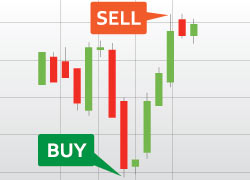Can anyone recall the first time they were introduced to technical analysis, did it feel like a Eureka moment, the sudden discovery that something happens when certain ‘numbers’ or horizontal lines on a chart are reached? Occasionally it’s worth reverting back to those sunnier more innocent days, particularly if, as many of us do from time to time, you get a bit bogged down in your technique.
For those of you familiar with our blog you’ll know that I’m a forex trend trader, I refuse to get nailed down to or be defined as either a swing/position/trend trader as in my book it’s all the same territory. I use a combination of fundamental and technical analysis for my trading.
Looking back at my first intro to our wonderful world of charting I took intraday trades off a line chart only, it was a package courtesy of a spread betting firm. The charts were Pro Real Time and I still use them today, they sit alongside FXCC’s Meta Trader and Currenex well and offer slightly different functions and features, particularly the back test function which is superb. Like any package it takes a while to familiarise yourself with it and we’re all creatures of habit to one degree or another so I’m now comfortable with them given I know them inside out.
Anyhow, my first spread betting trades in 2005-2006 were on the UK FTSE, I’d wait for price on a line chart to cross the 21 ma…honestly that was it..dumb or what!? I’d then exit if I saw a kinda “v shape ‘thingymabob’, upside down or the right way up” as I’d instinctively recognised that price momentum had probably exhausted. At first I didn’t have a clue what money management was, I’d just aim for those v or inverted v shapes. I did OK, a damn site better than most hedge funds since 2010 that’s for sure, hey, what matters is I didn’t lose money in my first couple of years trading, bar a nominal sum in my first practice account.
I suffer no traces of embarrassment when discussing my first foray into the markets, not as an investor (I’d been that for some time previous), but as a trader and speculator. On occasion I’m reminded of how instinctively I was, all those years back, actually on the right track. I had inadvertently discovered a basic form of money management, had the one simple set up, on a very liquid (albeit arguably highly synthetic market), was reading the business news in order to take the temperature of market sentiment and was beginning to understand the relationship between that sentiment (the fundamentals) and the action it would determine on my chart.
The reason I refer to the line chart is that I suddenly remembered an online conversation I’d had with a trader whose views I respected who started with line charts and has stuck with them…for decades. The fact that he’s so relaxed and still in the game answers the questions regarding his proficiency and profitability.
None of those new fangled Heikin Ashi candles or inside bars for him and his views on “gastric band, no flight zone, parabollox ash clouds” are still as humorous as ever. His view of market open and close times for our forex industry are equally revelatory, “the market opens on Monday morning shuts Friday evening, that’s it, all your other market open close times are so the real movers and shakers can go and get drunk..” actually he uses a slightly different word for drunk…
[quote]Price has no timeframe, it starts moving on Monday morning and doesn’t stop until Friday evening. When you look at any timeframe lower than one week you think you see “opens” and “closes” which aren’t really there, they’re imaginary. Trying to find patterns or deduce any meaningful information from these imaginary levels is ridiculous, building indicators around imaginary points is even worse.
If you really want to see how price moves over a period of, perhaps a week, change your chart from candlestick to line, set the timeframe to one second and scroll out so there’s a weeks worth of information on it. Price goes up and it goes down, but it doesn’t stop at 5pm then start again, it’s continuous![/quote]
Folk describing candles as; “measuring the strength of a move, the momentum of a wave, the prevalence in orders in x amount of time, the range of market movement in x amount of time, the increased or decreased volatility, giving you a 50% win lose probability via reference points” etc. are met with a shrug of the shoulders and a “so what, you telling me a line chart can’t do all that without the altered state of consciousness ‘voodoo’ language?”
As with my first adventure in trading, he still uses a line chart, he looks for price to cross two moving averages on a 4 hr and the daily chart and that’s it, even better if there’s looming big round numbers on the radar, or S1 and R1. With him it’s all about sound MM. Set up occurs, he pulls trigger, looks for 1:2 RR…that’s it.
Now we all refine our technique down to micro management levels and in itself that’s a good thing, however, from time to time it’s worth remembering where you began to make the journey and realise that every system can work and often the simpler the better..





